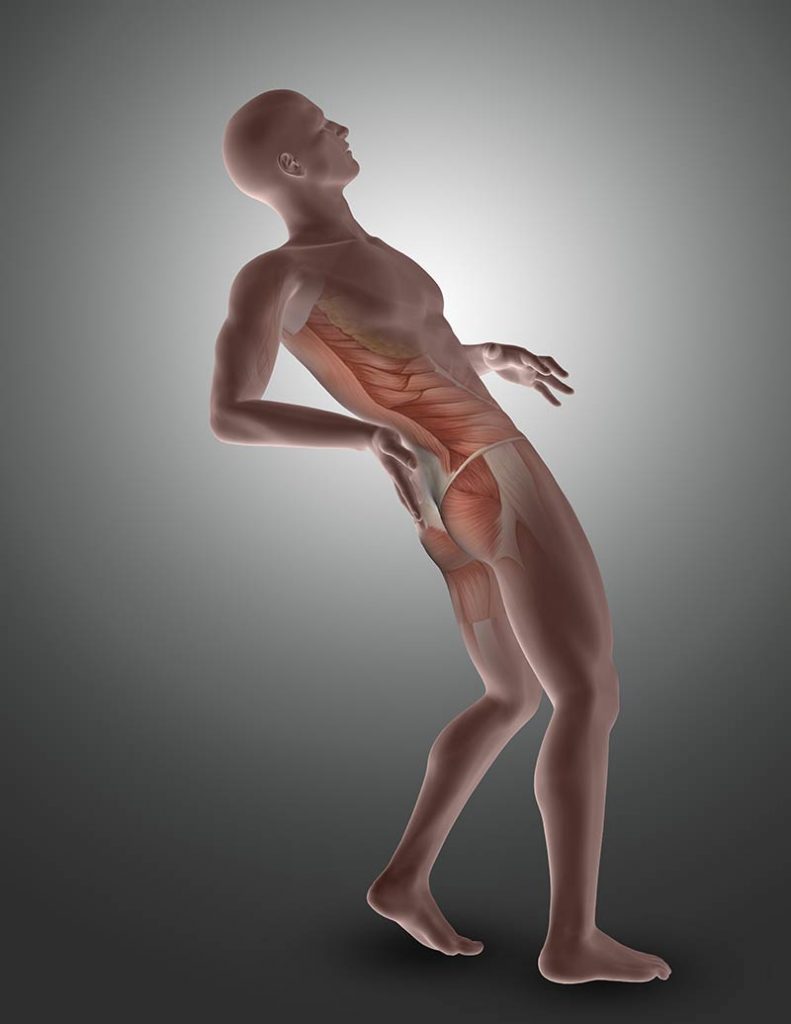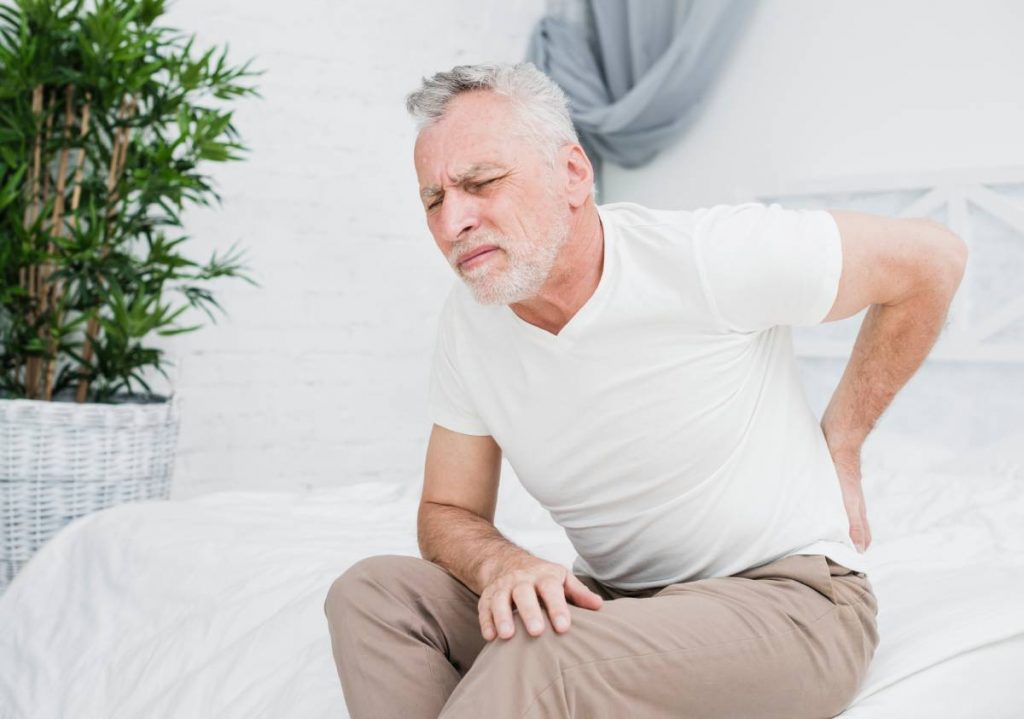Table of Contents
- What is the Psoas Muscle?
- How Does the Psoas Cause Lower Back Pain?
- Symptoms of Psoas-Related Conditions
- Seek Professional Help for Persistent Pain
Lower back pain can develop for many reasons, ranging from a lumbar spine issue to a back muscle strain. It is a leading medical condition and, in the most serious cases, leads to disability. In the U.S., up to 80% of people will experience low back pain at least once in their lifetime, and on any given day, approximately 26% are dealing with it.
One cause of lower back pain is an issue with the psoas muscle, a deep muscle that connects the lower spine to the thigh bone (femur). This muscle is used in most movements, so a painful psoas strain or tear interferes with most activities, from walking to recreational activities.

What is the Psoas Muscle?
The psoas muscle is a long, deep muscle in the lower back. It is located on each side of the spine and connects the spine right below the ribcage to the femur.

The psoas major muscle arises from the T12 vertebra and runs down the spine to pass deep into the ilioinguinal ligament. At that point, it forms a tendon right past the hip joint and connects to the femur. Innervation of the psoas muscle occurs at the L1-L5 vertebrae, where nerves are supplied to each side of the spine and activated. At L1-L3, innervation occurs to the lumbar plexus, a network of nerves in the lower back where T-12 to L5 vertebrae exit the spinal cord via the openings between adjacent vertebrae (called intervertebral foramina).
The psoas major muscle plays a crucial role in enabling hip flexing. For instance, when lying on your back, you can bend your knee towards your chest because of the psoas major muscle. This function underscores the importance of the psoas muscle in your daily movements.
Another muscle on each side of the spine is the iliacus muscle. It is a triangular-shaped muscle connected to the hip bone’s concave area in the front and connects with the psoas muscle. This forms the iliopsoas muscle, which is attached at the bottom of a bony prominence on the femur.
So, there are two sets of muscles working together. The psoas muscles are closest to the spine, and the iliacus muscles are next to the psoas muscles. The psoas major and iliacus (the iliopsoas muscle) enable hip flexibility and lumbar spine movements.
How Does the Psoas Cause Lower Back Pain?
The psoas muscle and the iliacus muscle can cause lower back pain when one of several conditions exists. The causes of psoas muscle pain overlap somewhat.
1. Psoas muscle tightening
The psoas muscle can tighten to the point that it causes pain. The muscle may be irritated or inflamed, tightening and sometimes compressing lower back discs. The tightening of the muscle may be caused by long periods of sitting that cause the muscle to shorten or overuse at work or during athletic activities. The tight psoas symptoms present as low back pain, pain in the groin, radiating pain towards the knee, and difficulty sustaining a fully erect posture. A tight psoas is also caused by emotional stress, arthritis, and overuse.
2. Psoas syndrome
Psoas syndrome is a group of symptoms associated with an injury to the iliopsoas muscle. It differs from muscle tightening in that it is an overuse or trauma injury, like a psoas muscle tear, commonly occurring in athletes and dancers, and producing a set of symptoms. The main symptom is groin pain, which may feel like lower back pain. Psoas syndrome is also called iliopsoas tendinitis, impingement, or internal snapping hip. The syndrome may be secondary to iliopsoas bursitis or other musculoskeletal disorders like chronic iliopsoas tightening.
3. Iliopsoas bursitis
Pain is caused by inflammation of the iliopsoas bursa, which separates the tendon or muscle from the bone, reducing friction between the hip and muscles.
4. Iliopsoas tendonitis
This hip disorder can cause chronic low back pain. The iliopsoas tendon connecting the lumbar spine and the upper femur becomes inflamed due to frequent compression or pinching. Often, the tendon and bursa are both inflamed because of their proximity.
Symptoms of Psoas-Related Conditions
The symptoms of a tight or injured psoas muscle include the following.
- Deep, dull, aching pain in the hips, pelvis, or lower back
- Buttock pain that may radiate down to the knee
- Tightness in the groin in front of the hip
- Having difficulty standing up straight after sitting for an extended period
- Back pain when standing or walking
- Limping
- Lower back spasms
- Reduced flexibility
- “Snapping hip,” in which the iliopsoas tendon rubs the bony femur prominence and makes a snapping or popping sound.

What does psoas pain feel like? The pain may be a dull ache, but sometimes, a sharp pain is experienced with sudden movements. A tight psoas muscle may cause a dull, deep pain, mainly in the lower back area. In many cases of a tight psoas muscle, lower back pain right above the buttocks, and stiffness in the lower back are experienced. A psoas muscle tear may cause hip tenderness, including swelling or bruising, thigh discomfort, and trouble sitting or standing. The type of pain experienced is different for each person.
Seek Professional Help for Persistent Pain
It is essential to pay attention to the body’s signals that indicate a health issue exists. Psoas muscle pain is your body signaling a medical condition needing attention. When the pain persists, it is crucial to see a doctor for an evaluation, especially when the pain is accompanied by other symptoms, like difficulty performing everyday activities due to muscle tightness. Most treatment plans to address the symptoms of a tight psoas are conservative and involve performing muscle stretching exercises and learning how to keep the psoas muscle flexible.
Sources
- https://www.ncbi.nlm.nih.gov/books/NBK586768/
- https://www.ncbi.nlm.nih.gov/books/NBK535418/
- https://www.ncbi.nlm.nih.gov/books/NBK551701/
- https://link.springer.com/article/10.2165/00007256-199825040-00005
- https://www.physio-pedia.com/Iliopsoas_Tendinopathy
- https://www.ncbi.nlm.nih.gov/books/NBK560799/
